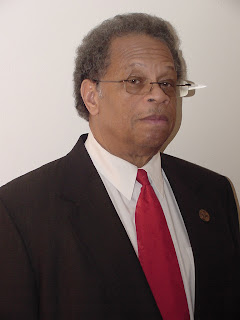
Monday, April 13, 2009
Urban School District: Focus on Community School to Enhance Performance
This presentation will focus on Normandy School District an urban school district investigating the concepts and researching the performance outcome of the community school model to improve performance. The community school model is planned based on two common goals: helping students learn, succeed, strengthening families and communities. If community characteristics such as poverty are strongly associated with student achievement, then efforts to improve student performance must focus on the community as a whole, not just on the school. Full-service community schools understand that raising student achievement in schools must involve more than academics. Full-service schools have the potential to end the cycle of poverty that consistently puts and keeps some students behind their peers even before the school bell rings.
Research has shown a strong correlation between areas with high levels of poverty, crime, and mobility and low student achievement. Despite these challenges, studies also show that supportive neighborhoods can mitigate the harmful effects of economic disadvantage on students and form the foundation for high achievement (Holloway, 2004). Education reforms will have a limited effect if they focus solely on the classroom. Policymakers need to consider what research has shown to be true—what happens in the community can and will affect the teaching and learning that happens in schools.
The framework of the community school will provide high-quality after-school opportunities, comprehensive early childhood education, real-world learning approaches, and physical and mental health services for adults and young people in the neighborhood. The services are designed to remove barriers to learning, make community assets fully available to address the needs of learners, and build bridges between schools, families, and communities based on mutual investment in the comprehensive well-being of communities.
The presentation will present successful community school initiatives
Blank, M. J., Melaville, A., & Shah, B. P. (2003, May). Making the difference: Research and practice in community schools. Washington,
Holloway, J. H. (2004, May). Research link: How the community influences achievement. Educational Leadership, 61(8), 89–90.
Research has shown a strong correlation between areas with high levels of poverty, crime, and mobility and low student achievement. Despite these challenges, studies also show that supportive neighborhoods can mitigate the harmful effects of economic disadvantage on students and form the foundation for high achievement (Holloway, 2004). Education reforms will have a limited effect if they focus solely on the classroom. Policymakers need to consider what research has shown to be true—what happens in the community can and will affect the teaching and learning that happens in schools.
The framework of the community school will provide high-quality after-school opportunities, comprehensive early childhood education, real-world learning approaches, and physical and mental health services for adults and young people in the neighborhood. The services are designed to remove barriers to learning, make community assets fully available to address the needs of learners, and build bridges between schools, families, and communities based on mutual investment in the comprehensive well-being of communities.
The presentation will present successful community school initiatives
Blank, M. J., Melaville, A., & Shah, B. P. (2003, May). Making the difference: Research and practice in community schools. Washington,
Holloway, J. H. (2004, May). Research link: How the community influences achievement. Educational Leadership, 61(8), 89–90.
Subscribe to:
Posts (Atom)